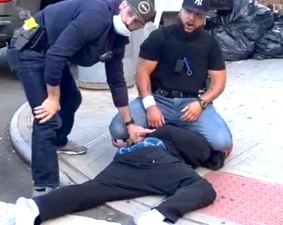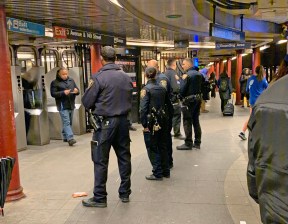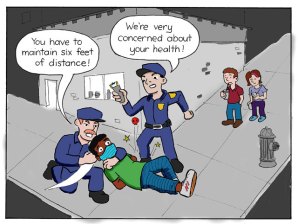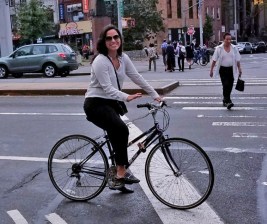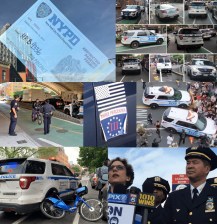Council: NYPD Must Stop Discriminatory Social Distancing Enforcement
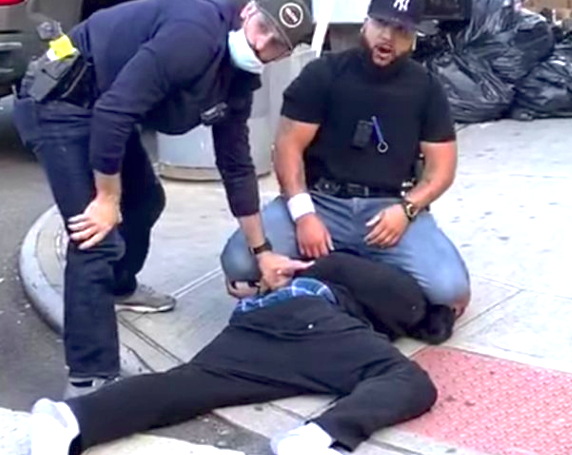
The NYPD’s enforcement of social distancing during the COVID-19 crisis is resulting in more of the same historical patterns of harassment against black and brown New Yorkers in open space — a misguided extension of broken windows policing, local pols are charging.
At a Friday hearing on NYPD enforcement, members of the City Council blasted the agency for disproportionately ticketing and arresting people of color for alleged social distancing violations, citing an analysis by Legal Aid, which found that almost 79 percent of summonses and 74 percent of arrests related to COVID-19 were handed down in majority black or Latino precincts, despite the fact that the majority of 311 calls for people flouting such guidelines were made in wealthier, white neighborhoods.
“We are seeing the emergence of stop and frisk 2.0. We are seeing a practice of selective enforcement,” said Brooklyn Council Member Inez Barron, a member of the Black, Latino and Asian caucus.
“The NYPD hasnt done their homework, they’ve been elusive, evasive, dismissive…..We are seeing the emergence of #stopandfrisk 2.0. We are seeing a practice of selective enforcement.“ -Councilmember Inez Barron at @NYCCouncil hearing on NYPD role in #SocialDistancing
— CPR Action (@CPRAction) May 22, 2020
Council Speaker Corey Johnson shared her and others’ concerns.
“Given that the vast majority of 311 complaints are coming from predominantly white neighborhoods, but the vast majority of summonses and arrests have happened to people of color, there seems to be a mismatch,” he said.
The hearing followed an earlier report revealing that more than 90 percent of people arrested or summonsed by the NYPD for not socially distancing were black or Hispanic — statistics that were revealed after at least three viral videos of cops violently arresting black and brown New Yorkers for alleged social-distancing violations, including in the East Village, East New York, and Long Island City.
To ensure the safety of everyone, police must not be the sole enforcers of public space, according to Queens Council Member Daneek Miller, who argued that Mayor de Blasio’s rollout of 45 miles of open streets for safe and socially distanced recreation does not create safe space for everyone if police are the ones patrolling it; black New Yorkers may be safe from cars, but not from armed officers, said Miller.
“Open streets could become a venue for questionable police enforcement, and so the jury is still out,” said Miller.
But the data is not shocking — it follows decades of disproportionate police enforcement in the way New Yorkers of color move about the city, like taking the subway, crossing the street, and riding a bike.
Streetsblog recently reported that 99 percent of tickets issued for jaywalking were given to black and brown people. From Jan. 1 to March 31, police wrote 80 tickets for illegal crossing — 78 of the 79 tickets for which a race was listed were written to black or Hispanics, while just one went to a person identified in police logs as “white.” Similar 2019 numbers were reported by Streetsblog, yet nothing changed.
On the subways, enforcement has repeatedly fallen hardest on New Yorkers of color: almost 90 percent of arrests and 70 percent of summonses for fare-beating in the first three months of 2019 were levied against black and Latino riders, Streetsblog reported last November.
And on a bicycle, Streetsblog reported back in 2014 that of 15 neighborhoods where police handed out the most summonses for cycling on the sidewalk, 12 were mostly black or Latino.
The disproportionate enforcement against people of color in the name of social distancing is no different, and must end, said Public Advocate Jumaane Williams.
“I do not believe the NYPD should be the primary agency tasked with public health guidelines,” said Williams. “Yes, we should distribute more masks at parks…and create open spaces by expanding several miles of open streets, but the effectiveness of these measures depend on who is responsible for their enforcement.”
Mayor de Blasio has long defended the NYPD’s role in policing open space. Earlier this month, after a Council budget hearing where several lawmakers called for cuts to the NYPD, Streetsblog asked the mayor if he would at least consider transferring some of the NYPD’s portfolio back to the Department of Transportation, which “could do it more efficiently and even maybe with less controversy.”
The mayor started by saying, “I just disagree with the construct [of the question],” then continued:
I look at what’s happened in the last six years of Vision Zero and I remind everyone, with deepest respect to all my predecessors, this administration decided to do something absolutely radical and put Vision Zero in place, and I remember the first months, I remember the naysayers, I remember the people said it would be politically unpopular, it would be impossible, it wouldn’t work, it would be too controversial and I’m very proud to say we forged ahead anyway and in fact built it bigger each year and overwhelmingly Vision Zero has worked and I think you will remember even before he became our first Police Commissioner in this administration, Bill Bratton talked about the importance of the NYPD playing on a more directed energetic focus role in stopping these fatal crashes and protecting lives in terms of traffic and he, along with Polly Trottenberg and her team at DOT, folks at TLC, folks at City Hall, we all built this vision together and there has been consistent success with Vision Zero in large measure because NYPD has been at the table and an active full participant throughout. So that’s not changing. In fact, I’m a big believer, you’ve heard me say it in more and as we get back to normal, we’re going to go right back to this. You know, more and more and more NYPD enforcement on speeding, on failure to yield, more speed cameras, which have proven to be so effective, and we’ve been building them out around schools. No, we’ve got a strategy that’s overwhelmingly been working, we’re going to stick to it. We’re going to build upon it. The only reasons for delays lately have been because of work that wasn’t happening, couldn’t happen under these conditions. But once we get a little bit better, we’re going right back to all the Vision Zero physical work, and on the PD budget.
